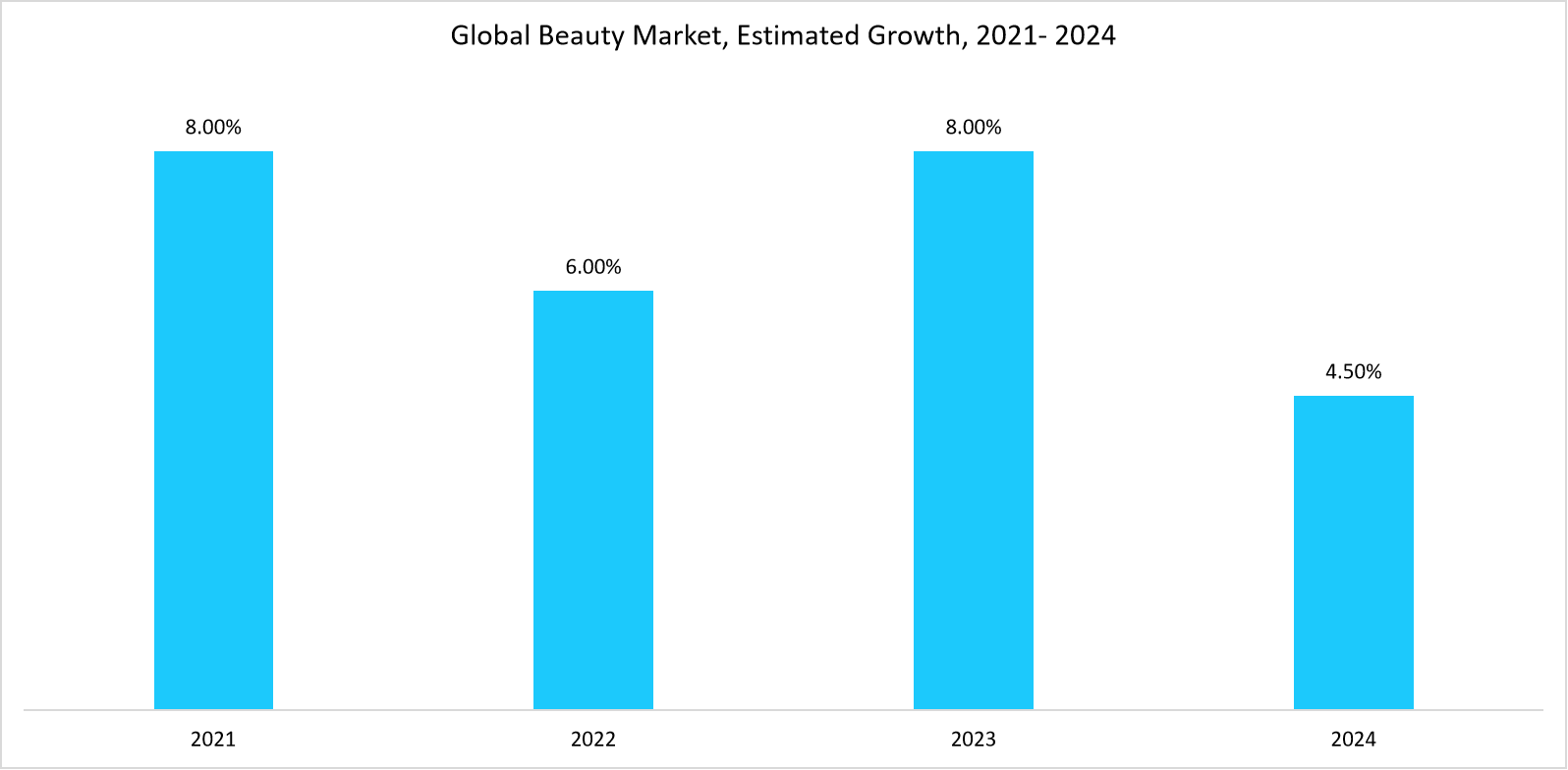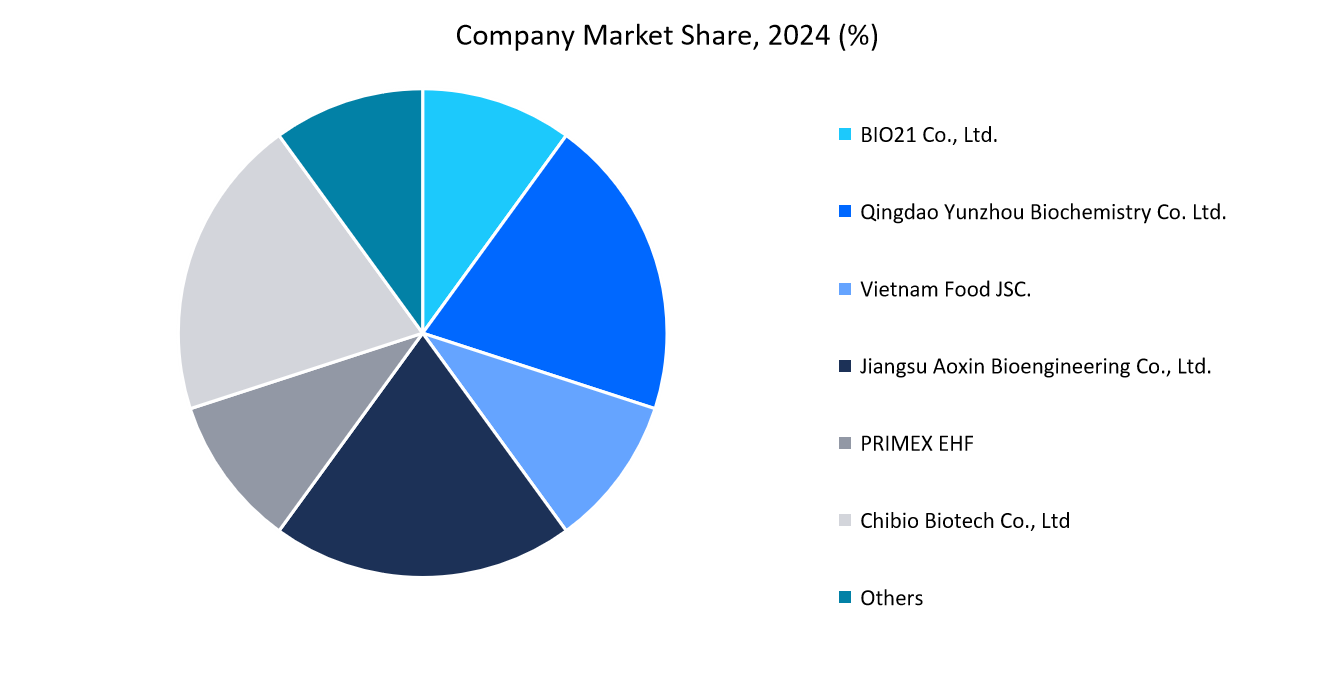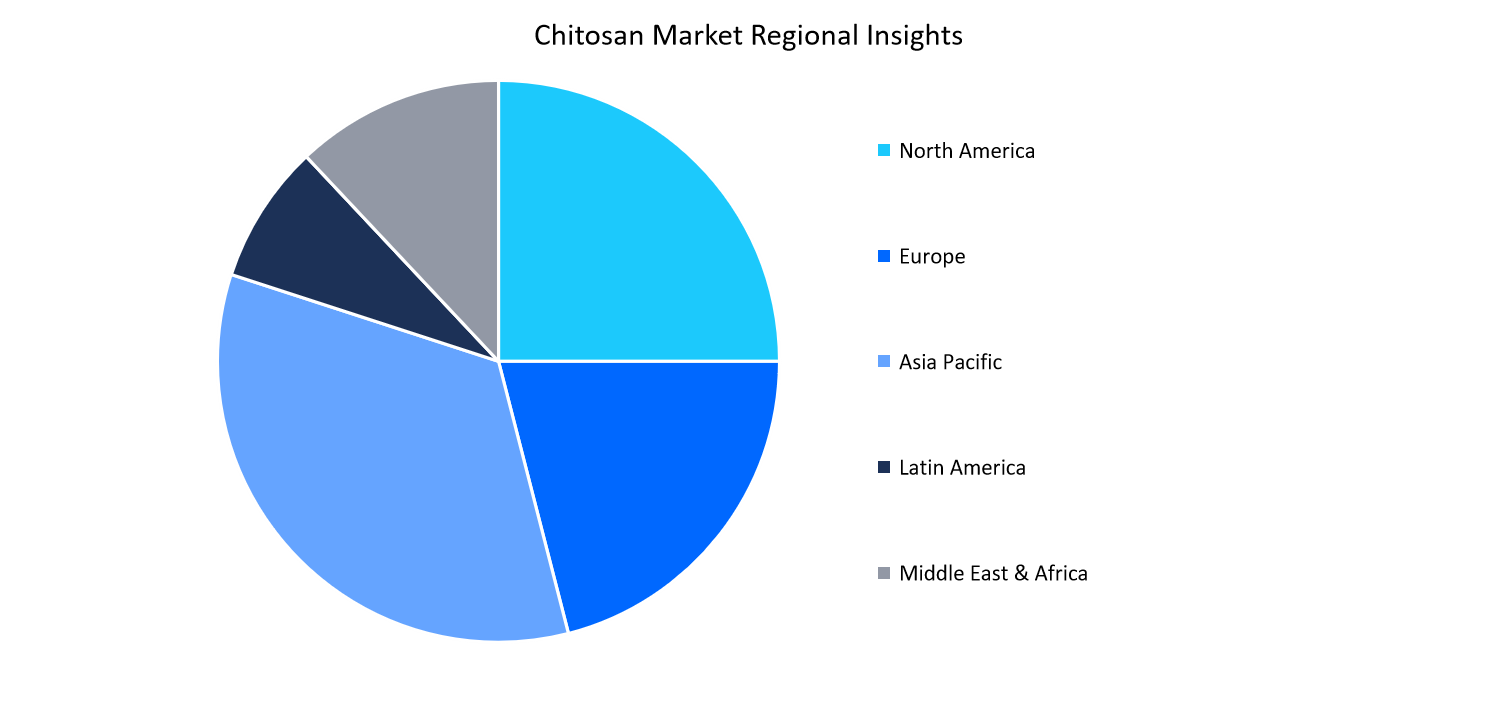Chitosan Market Overview
The global chitosan market size was valued at USD 2.20 billion in 2024 and is projected to reach from USD 2.42 billion in 2025 to USD 5.63 billion by 2033, growing at a CAGR of 10.2% during the forecast period (2025-2033). The chitosan market is driven by rising demand for bio-based polymers from the cosmetics industry and rising utilization in the agrochemical industry for use as a pesticide. This demand for chitosan creates a need for raw materials to extract chitosan, and India is one of the major exporters of seafood such as shrimp, which is one of the sources of chitosan.
Key Market Indicators
- Asia Pacific was the largest market in 2024, holding a revenue share of 34.55%, driven by shrimp aquaculture and the presence of major chitosan manufacturers.
- Based on Source, Shrimp dominated the chitosan industry in 2024 with a revenue share of 28.83%
- Based on Form, Powder form led the market in 2024 with a revenue share of 36.57%
- Based on End Use, Biomedical & Pharmaceutical was the dominant segment in the global market in 2024
Market Size & Forecast
- 2024 Market Size : USD 2.20 Billion
- 2033 Projected Market Size : USD 5.63 Billion
- CAGR (2025-2033) : 10.2%
- Largest market in 2024 : Asia Pacific
- Fastest-growing region : North America
The export of shrimps from India is increasing year on year, highlighting the increased demand for raw material for manufacturing chitosan. The table below indicates the quantity of shrimps exported from India and the year-on-year increase percentage.
Export of Frozen Shrimp from India, 2022-2024
|
Year |
Quantity (MT) |
% Increase |
|
2022-2023 |
7,11,099 |
- |
|
2023-2024 |
7,16,004 |
2.67% |
Source: Press Information Bureau, India
In the list of importing countries, the U.S. ranked first, followed by China, and then the European Union. This order of demand signifies that major countries are focused on the production of chitosan according to the rising need, and hence they are importing the raw materials, directly reflecting in market growth.
Chitosan is a biopolymer, the second most abundant biopolymer on earth, after cellulose. It is extracted from various sources such as insects, crustaceans, and many fungi. Chitosan is refined from chitin, and it is 100% biocompatible, biodegradable, and hypoallergenic. With these bio-based properties, chitosan is getting highlighted for its use in cosmetics and drug delivery systems. Furthermore, with a wide source range, chitosan has a wide range of applications across multiple industries with multiple roles to play, such as pharmaceuticals, agriculture, food and beverages, and other industries. This wide variety of applications marks the demand for chitosan.
Market Trends
Shift towards Biodegradable Chitosan by the Packaging Industry
The food packaging and coating industry is tracking the demand for biodegradable chitosan over other plastic products. Awareness amongst people is rising regarding the use of nature-friendly products for packaging and coating, as other products are deteriorating the packaged food and developing undesired products. Major manufacturing companies such as Chitinor, ChitoLytic develop and manufacture biodegradable chitosan. The availability of biocompatible chitosan aligns with the rising demand for biodegradable chitosan.
Chitosan Serving the Medical Sector with an Inhaled Drug Delivery System
Chitosan is getting advanced in terms of its applications across various sectors. As it has a strong importance in the medical sector with a wide variety of applications, the ongoing research always keeps chitosan in an upgradation mode with advancements.
- For example, in July 2025, Iterro Life Sciences introduced trū Chitosan, a first commercially available chitosan for inhaled drug delivery. This chitosan is pure and consistent to be applicable as an inhalant.
Such innovative developments push chitosan to penetrate in medical sector and offer multiple applications, thereby driving market growth.

To get more insights about this report Download Free Sample Report
Chitosan Market Growth Factors
Strong Growth of the Cosmetics Industry Creating Demand for Chitosan
Chitosan is one of the crucial components of cosmetics, offering protection to skin, maintaining skin moisture, and promoting natural skin renewal. These properties of chitosan reflect its demand in the cosmetic industry. The continuous growth of the beauty market signifies the rise in demand for chitosan.
- According to L'Oréal, the beauty market is growing over the years. The graph below indicates an estimated growth over the years.

Source: Loreal
This continuous growth every year highlights the rise in the use of beauty care products, propelling the demand for chitosan as one of its crucial components.
High Prevalence of Skin Disorders
The high prevalence of skin disorders amongst children and adults is demanding an efficient solution. For instance, according to the National Eczema Association, atopic dermatitis is one of the major types of skin disorders, and 16.5 million adults and 9.6 million children in the U.S. are living with atopic dermatitis. In concern to this regard, chitosan-based drug delivery systems came into the picture, promoting wound healing. This high prevalence of atopic dermatitis and other skin disorders potentiates the demand for chitosan to develop and manufacture chitosan-based drug delivery systems, thereby driving the market growth.
Market Restraining Factor
High Competition from Alternative Products
Chitosan is gaining traction across various industries with increasing demand as a bio-based product. But there are certain alternative products that are of natural origin and impose similar applications as that of chitosan. For example, in the case of packaging, bio-based polymers such as starch, cellulose, agar, and casein are alternative packaging raw materials to chitosan. As these materials are of biological origin, they directly impose high competitiveness to chitosan, impacting the market growth.
Market Opportunity
Collaborative Investments by Major Market Players
As chitosan is being adopted as a bio-based solution across multiple industries, manufacturers are becoming aware of the increasing demand for chitosan. So, accordingly, the companies are investing in the manufacturing of chitosan to increase the production capacity.
- For example, in February 2025, Tidal Vision invested USD 140 million in collaboration with SPG, Eni Next, Milliken & Company, KIRKBI Climate, Convent Capital, SWEN Capital Partners' Blue Ocean Fund, MBX Capital, and Oman Investment Authority's IDO Investments.
Such big investments by the chitosan manufacturing companies present opportunities for market growth via high development and production capacities.
Regional Analysis
The Asia Pacific region dominated the market with a revenue share of 34.55% in 2024. The growth is attributed to the presence of major market players such as Qingdao Yunzhou Biochemistry Co., Ltd., Panvo Organics Pvt Ltd., Jiangsu Aoxin Bioengineering Co., Ltd., Chibio Biotech Co., Ltd, and Vietnam Food JSC. In addition to this, countries such as India deal with the aquaculture of shrimps, which is one of the sources of chitosan. This culturing has made India a dominant exporter of shrimps, promoting the development of chitosan and driving the market growth.
Countrys Insights
The Chitosan market is experiencing dynamic growth and diversification across the globe, with each country contributing uniquely to the advancement of this transformative field.
- U.S.- The U.S. government is promoting the development of chitosan-based nanocomposites through machine learning. For instance, President Biden’s 2025 budget requested over USD 2.2 billion for the national nanotechnology initiative. This initiative comprised machine learning for the design and characterization of chitosan-based nanocomposites.
- UK- Initiatives are being taken in the UK to develop bottles for the packaging of liquid food materials. For example, UK Research and Innovation conducted a project to ferment chitosan from vegetal waste streams and apply it to Pulpex fibre bottles to make them suitable to package liquid food.
- India- A Rising number of issues associated with plastic packaging in the food industry is potentiating the need for bio-based packaging material. For instance, in January 2024, scientists from the Institute of Advanced Study in Science and Technology (IASST), India, developed a novel biopolymer film synthesized from chitosan, sodium alginate, and mushrooms that offers resistance to chemicals, has printable properties, and is edible. Such products potentiate the demand for chitosan.
- South Korea- Ongoing research and development by scientists are putting forth the growing applications of chitosan. For example, in December 2024, scientists from Chungnam National University, South Korea, developed edible biofilm made of chitosan for extending the shelf life of fruits.
- Brazil- Brazil is strengthening the agricultural trade relations that promote the demand and supply of chitosan as a pesticide. In March 2025, the agriculture ministries of Brazil and Chile met to strengthen trade relations.
- South Africa- Seborrheic dermatitis is a major skin disorder, where chitosan exhibits excellent biocompatibility, biodegradability, and broad-spectrum antibacterial properties. For instance, the prevalence of Seborrheic dermatitis is 8.82% in South Africa, which is the highest compared to other countries. This high prevalence significantly demands chitosan-based products for wound healing, and hence, the demand for chitosan to develop the products.
Source Insights
The shrimp segment dominated the market with a revenue share of 28.83% in 2024. The growth is attributed to its high availability in the market through aquaculture, followed by a high margin in countries such as India. These cultured shrimps are either processed domestically to extract chitosan or exported to other countries. For instance, India reached a time high export of seafood in the year 2023-2024. India shipped 17,81,602 MT of seafood, where frozen shrimps accounted for the major share along with frozen fish. In addition to this, the top export destinations were China and the U.S., the countries having high production capacity of chitosan.
Form Insights
The powder segment dominated the market with a revenue share of 36.57% in 2024. The growth is attributed to the better physicochemical properties over other forms, such as better solubility, compatibility in end-use industries such as pharmaceuticals, water treatment, and cosmetics. In addition to this, powder form is easy to handle, store, and transport.
End Use Insights
The biomedical & pharmaceutical segment dominated the market with a revenue share of 27.49% in 2024. The growth is attributed to a wide range of applications in the pharmaceutical domain, such as coating material, packaging material, wound healing, tissue engineering, and the development of novel drug delivery systems. Its encapsulating properties promote the pharmacological activity of the drug and reduce the side effects, enhancing patient experience.

The Global Chitosan Market is consolidated in nature due to increasing demand for biocompatible polymers, manufacturers’ collaborative investment to ensure the development of new products, and increasing manufacturing rate to align with the rising demand. Companies such as DPH biologics signed a licensing agreement with Kitozyme to develop sustainable chitosan seed treatment technology for advancement. The top players in the industry are BIO21 Co., Ltd., Qingdao Yunzhou Biochemistry Co., Ltd., Vietnam Food JSC., Jiangsu Aoxin Bioengineering Co., Ltd., and PRIMEX EHF.
BIO21 Co., Ltd.: An emerging player in the Chitosan market
BIO21 Co., Ltd., a dedicated chitosan manufacturing company established year of 2003. The first factory for the production of chitin and chitosan was opened in 2004. BIO21 Co., Ltd. manufactures chitosan sourced from shrimp shells, crab shells, and squid pens. The company has achieved certifications from the European Union, GMP, and HACCP. With such certifications and a strong product portfolio, BIO21 emerges out to be one of the major manufacturers of chitosan.
Recent developments by BIO21 Co., Ltd
- In March 2024,BIO21 Co., Ltd. opened a new chitosan manufacturing plant with a capacity of 60-80 MT per year
List of key players in Chitosan Market
- Golden-Shell Pharmaceutical
- ADVANCED BIOPOLYMERS AS
- Qingdao Yunzhou Biochemistry Co., Ltd.
- PRIMEX EHF
- Heppe Medical Chitosan GmbH
- Kitozyme, LLC
- Panvo Organics Pvt Ltd.
- Jiangsu Aoxin Bioengineering Co., Ltd.
- The Seagarden Group (Chitinor)
- Chibio Biotech Co., Ltd
- BIO21 Co., Ltd.
- ChitoLytic
- CuanTec
- CHITOSAN INDONESIA
- Vietnam Food JSC.
- Others

To get more findings about this report Download Market Share
Recent Developments
- In September 2025 : Singapore’s start-up company Greenitio invested USD 1.5 million to scale up its biopolymer platform to turn chitosan derived from mushrooms into functional polymers for cosmetics. This investment significantly demands chitosan for developing polymers for cosmetics.
- In August 2025 : Tidal Grow’s Spectra received approval for use on California crops. The active ingredient for Spectra is chitosan. This approval influences the demand for chitosan to be utilized in the manufacturing of Spectra.
- In February 2025 : Tidal Grow AgriScience, a division of Tidal Vision Products Inc., announced the Canadian launch of new agricultural products designed to support regenerative farming practices. The newly approved products include:
- Tidal Grow GENBOOST – A chitosan-based seed treatment that activates crop defence mechanisms and enhances seedling vigor.
- Tidal Grow Chroma – A chitosan-based bio stimulant formulated to improve plant health, stress tolerance, and yield potential.
Analyst Opinion
Rising demand for bio-based polymers highlights the demand for chitosan across multiple industries. Chitosan’s dominant role in healthcare, agriculture, and the cosmetics industry via drug delivery systems, wound healing purposes, manufacturers’ investment to scale up mushroom-based chitosan for cosmetic purposes, and approval as a safe agrochemical to be used in farming significantly directs the market growth. In addition to this, countries such as India hold a major share in the export of raw materials such as shrimp. In this way, a well-directed balance between demand and supply is expected to be continued for the upcoming years.
Report Scope
| Report Metric | Details |
|---|---|
| Market Size in 2024 | USD 2.20 Billion |
| Market Size in 2025 | USD 2.42 Billion |
| Market Size in 2033 | USD 5.63 Billion |
| CAGR | 10.2% (2025-2033) |
| Base Year for Estimation | 2024 |
| Historical Data | 2021-2023 |
| Forecast Period | 2025-2033 |
| Report Coverage | Revenue Forecast, Competitive Landscape, Growth Factors, Environment & Regulatory Landscape and Trends |
| Segments Covered | By Source, By Form, By End Use, By Region. |
| Geographies Covered | North America, Europe, APAC, Middle East and Africa, LATAM, |
| Countries Covered | U.S., Canada, U.K., Germany, France, Spain, Italy, Russia, Nordic, Benelux, China, Korea, Japan, India, Australia, Taiwan, South East Asia, UAE, Turkey, Saudi Arabia, South Africa, Egypt, Nigeria, Brazil, Mexico, Argentina, Chile, Colombia, |
Explore more data points, trends and opportunities Download Free Sample Report
Chitosan Market Segmentations
By Source (2021-2033)
- Squid
- Crab
- Krill
- Shrimp
- Others
By Form (2021-2033)
- Powder
- Solution
- Fiber
- Film
By End Use (2021-2033)
- Biomedical & Pharmaceutical
- Food & Beverages
- Cosmetics
- Agrochemicals
- Others
By Region (2021-2033)
- North America
- Europe
- APAC
- Middle East and Africa
- LATAM
Frequently Asked Questions (FAQs)
Anantika Sharma
Research Practice Lead
Anantika Sharma is a research practice lead with 7+ years of experience in the food & beverage and consumer products sectors. She specializes in analyzing market trends, consumer behavior, and product innovation strategies. Anantika's leadership in research ensures actionable insights that enable brands to thrive in competitive markets. Her expertise bridges data analytics with strategic foresight, empowering stakeholders to make informed, growth-oriented decisions.
Speak To AnalystAvailable for purchase with detailed segment data, forecasts, and regional insights.
Get This ReportOur Clients:











































